Hammarby Fotboll
Hammarby IF Fotbollförening, more commonly known as Hammarby Fotboll or Hammarby[1] (Swedish pronunciation: [ˈhâmːarˌbyː] or, especially locally, [-ˌbʏ]), is a Swedish football club from Stockholm founded in 1915.
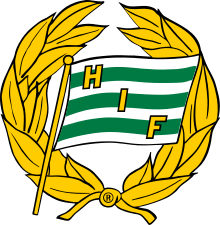 | ||||
| Full name | Hammarby IF Fotbollförening[1] | |||
|---|---|---|---|---|
| Nickname(s) | Bajen[note 1] | |||
| Short name | HIF | |||
| Founded | 7 March 1897 (as Hammarby IF) 13 August 1915 (football department) | |||
| Ground | Tele2 Arena, Stockholm | |||
| Capacity | 33,000 | |||
| Owner | Hammarby IF Fotbollförening – 51% AEG – 23.5% Zlatan Ibrahimović - 23.5% Other – 2% [2] | |||
| Chairman | Richard von Yxkull | |||
| Head coach | Stefan Billborn | |||
| League | Allsvenskan | |||
| 2019 | Allsvenskan, 3rd | |||
| Website | Club website | |||
|
| ||||
The club is based at Tele2 Arena in Johanneshov but founded in the neighbouring Södermalm district of Stockholm City Centre, an area the club considers its heartland.
Competing in Sweden's first tier, Allsvenskan,[3] Hammarby are placed twelfth in the all-time Allsvenskan table,[4] and has won the league once, in 2001.
The club's colours are green and white, which is reflected in its crest and kit. Between 1918 and 1978, however, the club played in black-and-yellow striped home shirts, which since often form the club's away colors.
It is known for its vociferous fans and for having the highest average attendance in the Nordic countries.[5] Drawing inspiration from England, Hammarby fans introduced football chants to the Swedish terraces in 1970.[6]
Hammarby is one of largest football clubs in Europe in terms of the number of active players of all ages – with some 3,000 players in its organisation.[7][8]
Hammarby Fotboll is affiliated with the Stockholms Fotbollförbund (Stockholm Football Association).[9]
History
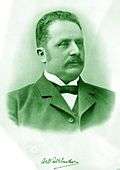
In 1889, Hammarby Roddförening ("Hammarby Rowing Association") was established in Södermalm, with engineer Axel Robert Schönthal, the first chairman, being credited as the founder.[10] By 1897, it had diversified into different sports, and was renamed Hammarby Idrottsförening ("Hammarby Sports Club"), or Hammarby IF for short.[11][12]
1915–1940s: Establishment of football club
In 1915, the sporting ground Hammarby IP was built in Södermalm. Due to a lack of football pitches in Stockholm, several other clubs proposed to merge with Hammarby IF to get access to the stadium. An offer from Klara SK was accepted and Hammarby officially established a football department on 13 August 1915.[13][14] The club played its first competitive game two days later, and won 5–0 against Västerås SK in the "Östsvenska serien", a local league.[15] In 1916, Hammarby competed in Svenska Mästerskapet, a cup by then held to decide the Swedish Champions, for the first time.[16] In 1918, Hammarby also merged with Johanneshofs IF, a club from the neighbouring district Johanneshov.[17]
In 1920, Hammarby first competed in the Svenska Serien, by then the highest league in Swedish football.[18] During the upcoming years, Hammarby had a strong showing where they went to the finals of Svenska Mästerskapet in 1922, losing 1–3 to GAIS.[11][19]
Hammarby qualified to compete in Allsvenskan's inaugural season in 1924. On 3 August said year, Rikard Larsson became Hammarby's first goalscorer in Allsvenskan, and also the first goalscorer in the league's history, in a 1–5 loss against Örgryte IS.[20] The club would eventually finish last in the 1924–25 Allsvenskan, and were relegated to Division 2, which was then the second highest league in Sweden.[11]
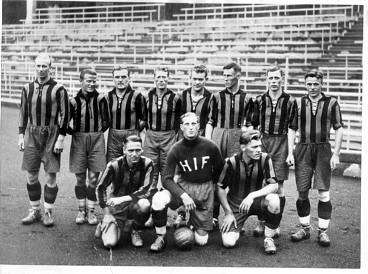
During the upcoming years, Hammarby failed to produce any sort of challenge in Swedish football. Several star players emigrated to the United States,[19] transferred to other clubs or opted to instead play ice hockey for Hammarby.[11] In 1936–37 and 1937–38, the club won the second division, but lost the playoff matches that would have promoted them to Allsvenskan.[21][22] Instead, Hammarby got promoted in 1938–39, where they knocked out IFK Norrköping following outstanding performances from goalkeeper and star player Sven "Svenne Berka" Bergqvist.[23]
Hammarby would, however, suffer from another relegation, finishing last in Allsvenskan in 1939–40. Back in Division 2, the club finished in the top four for the next six years. In the 1946–47 season, the club finished at the foot of the table, and because of a restructuring of the league system, the club got relegated to Division 4.
1950s–1960s: A period of yo-yoing
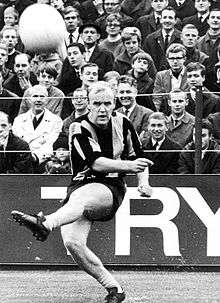
Hammarby did not return to the second highest league until the 1950–51 season. In the 1954–55 season, the club returned to Allsvenskan, but this time it finished sixth and managed to stay for another season. However, the club underwent yo-yoing, having been promoted and relegated between Allsvenskan and Division 2 seven times until 1970. Nacka Skoglund, one of the league's top players who played for Hammarby from 1944–49, returned to Hammarby to play from 1964–67.[24] In his return debut, he landed a corner kick into the goal minutes into the match;[24] in 1984, the club erected the Nackas Hörna (Nacka's corner) statue with his kick as the pose.
1970s–1980s: Stable Allsvenskan years
In the 1970 Allsvenskan season, Hammarby had acquired only 3 points in the spring portion of the season, but during the autumn, showed a dramatic improvement. With star players Kenneth Ohlsson and Ronnie Hellström, and with a crowd that tried out supporter songs for the first time, the club went through the autumn half undefeated and finished in fifth place, its best showing in Allsvenskan. The club would stay in Allsvenskan through the rest of the 1970s, attracting large crowds, despite not returning above fifth place. Also in 1978, the club changed from black/yellow to green/white colours.
In the 1982 season, Swedish football introduced a playoff system for the top 8 teams in Allsvenskan to decide a champion. The playoffs consisted of two matches in which the aggregate score would determine who would advance. The club had placed second overall that season and had not lost a home game. After defeating Örgryte in the quarter-finals, and coming back from a 1–3 deficit to beat Elfsborg 4–3 in the semi-finals, Hammarby was in the final against IFK Göteborg. Hammarby won its away match 2–1 to a sold-out crowd, but lost 1–3 in its home match.[note 2]
In the following year, Hammarby finished fifth in the league, but lost to AIK in the play-offs. In the Svenska Cupen tournament, Hammarby reached the finals but lost against IFK. However, since IFK qualified for the UEFA Cup that year, Hammarby qualified for the UEFA Cup Winners' Cup, its first major international competition, where the club lost to Finland's FC Haka in the second round. The Hammarby squads finished consistently in the top six in the league every year through 1987.[25]
In 1988, Hammarby finished last in the standings and were relegated to the second tier.[25] Although the club placed first in 1989,[26] it finished last in 1990.[25]
1990s–2000s: Tough nineties, restructuring, champions

Hammarby would stay in the second tier in 1991 and 1992, but in 1993, the team finished in first place and were promoted to Allsvenskan. In 1995 Allsvenskan, the team finished last and were relegated, but returned to the 1998 Allsvenskan with a third-place finish.[27]

Prior to the 2001 Allsvenskan season, the club had financially tough times, leading experts to conclude that the team was weak, and one journalist predicted a last place finish. Halfway through the 2001 season, manager Sören Cratz was informed that his contract would not be extended because the club's board wanted Hammarby to play a positive, attacking and fun football, something the board did not think that Cratz did.[note 3] However, the club took the lead in the standings and in the second-to-last match, which was against Örgryte IS on 21 October, the club won 3–2 and secured its first ever Allsvenskan championship.
Hammarby stayed in Allsvenskan for the rest of the 2000s: In 2003 Allsvenskan the club finished second, and participated in the second qualifying and first rounds of the 2004–05 UEFA Cup. In 2006 Allsvenskan, Hammarby placed third overall and advanced to the UEFA Intertoto Cup, where they won their third round match, which advanced the team to the second qualifying and first rounds of the 2007–08 UEFA Cup.
In 2007, Bajen finished on the sixth place, and didn't qualify for any European cups. In 2008, Hammarby finished ninth, but 2009 was a disastrous year where the team finished last in the league and was relegated to the second tier known as Superettan.
2010–2014: Superettan
The 2010 Superettan was a letdown for supporters who had hoped to make the visit to Sweden's second tier short, as the team finished 8th. In the 2010 Svenska Cupen, Hammarby fared better, winning against multiple Allsvenskan opponents, until the finals where the team lost 0–1 to Helsingborgs IF. In the 2011 Superettan season, the club finished in a tie for 11th, its worst overall ranking in 64 years. The club was almost relegated to the third tier, until a game-winning kick in the season's final match against Ängelholm. After the season of 2011, Hammarby dismantled their development team HTFF, which was established in 2003. In 2012 Superettan, the club finished fourth, and in 2013 Superettan the club finished fifth. In 2014, in the last round of the season, Hammarby were promoted to the first tier, Allsvenskan, by finishing first in Superettan.
2015–: Top-flight comeback
The 2015 season started off well, with Hammarby managing an impressive 1–2 away win against local rivals AIK in the 2015 Swedish Cup, which also was the first Stockholm derby involving Hammarby since 2009. This was followed up with a 2–0 win in the season opener against BK Häcken, and in the fourth round Hammarby defeated their other local rivals Djurgårdens IF with 2–1. The summer was, however, tougher for the club, with Hammarby playing 10 consecutive league games without winning, before managing to defeat Falkenbergs FF at home with 3–0. Eventually, Hammarby finished at 11th place in their first Allsvenskan season since 2009.
The 2016 and 2017 seasons showed only a slight improvement for Hammarby, with the team ending in the 11th and 9th position respectively. Hammarby fared better in the local derbys. In 2016 Hammarby defeated the local rival Djurgården in all three fixtures. In 2017 the first encounter ended with a draw and the second with a Hammarby victory. The second local rival, AIK, managed to defeat Hammarby by 3–0 in the first encounter in the league and a draw (0–0) in the second. Hammarby however beat AIK in the Swedish cup, earlier in the year. In 2017 the Hammarby - AIK encounters ended with one Hammarby win and one draw. Both Djurgården and AIK, however, fared much better overall than Hammarby in the league.
The club fared much better in 2018 under the reign of new manager Stefan Billborn, finishing 4th in the league. In 2019, Hammarby started the league play in a mediocre fashion, but made a strong finish to the season (with eight straight wins during between match day 22 and 30) and ultimately finished 3rd in Allsvenskan. This meant that the club qualified for the 2020–21 UEFA Europa League, their first continental competition in over ten years.[28]
Colours, badge and kit
Colours and badge
When Hammarby Roddförening (Hammarby RF) was founded in 1889, the club's crest consisted of a white flag with three green horizontal lines. It drew inspiration from two other competing rowing clubs in Stockholm that used two blue and two red lines respectively on a white flag, but chose the colour green since it represented hope. Hammarby eventually added a third stripe when it discovered that Göteborgs RF used a similar green-white flag with two stripes.[29]
Kit
When Hammarby IF founded its football club in 1915, it determined the kit to be the following: a white hat with a five-pointed green star, a white shirt with "HIF" on its chest, white shorts and black socks.[10] Following the merger with Johanneshovs IF 1918, the club changed its football team apparel to Johanneshov's black-and-yellow striped shirts, blue shorts and black socks with yellow stripes.[17] The first department to use the new kit was Hammarby Bandy, with the football department adopting it soon thereafter.[30]
In the 1960s, the club changed from blue shorts to black. When "Nacka" Skoglund rejoined the club in 1964, he donated the club a set of black shorts because he thought the team's blue shorts looked awful.[30]
In 1978, 60 years after the merger with Johanneshov, Hammarby changed its home colours from black and yellow to white shirts, green shorts and white socks. In 1997, the striped shirts returned, but with green and white colours, with green shorts and white socks. The yellow and black colours were retained for the away and third kits. Since 1997, only a few exceptions have been made to the green-and-white-striped home and the black-and-yellow-striped away shirts: In 2002 and 2014–2016, the team wore all-white jerseys, and in 2011 the team wore an all-grey away kit.
Craft is Hammarby's kit manufacturer.[31] Also visible on the club's kit, in 2019, were the logos of the following sponsors: Jobman, a workwear company; automakers Volkswagen; Intersport, a sporting-goods retailer; Sefina pantbank, a pawnbroker; Silja Line, a cruiseferry brand; Yokohama, a tire company; Fronta, a professional-merchandise company; Clinton, a construction measurement company; and league sponsors Svenska Spel, a state-owned gambling company (whose logo is on the right sleeve of the shirts of all Allsvenskan teams).[32]
| Period | Kit manufacturer | Shirt sponsor (chest) |
|---|---|---|
| 1994–1995 | Oddset | |
| 1996–1998 | Folksam or Oddset | |
| 1999 | Folksam or Falcon | |
| 2000–2001 | Folksam, Falcon or Kungsörnen | |
| 2002–2003 | Coop | |
| 2004–2005 | Siemens | |
| 2005–2006 | ||
| 2006 | BenQ-Siemens | |
| 2007 | UNICEF | |
| 2008–2009 | Finlux | |
| 2010–2011 | Pepsi | |
| 2011 | ||
| 2012 | None | |
| 2013 | Herbalife | |
| 2014 | ||
| 2015–2017 | LW | |
| 2018 | Jobman Workwear | |
| 2019– |
Ownership and finance
Ownership
Hammarby IF was reorganised as an umbrella organisation in 1999, with each of the individual sports departments breaking off to form independent clubs; the football club was then named Hammarby IF Fotbollförening (Hammarby IF FF).[33]
In 2001, the football club split the A team, B team and youth team into separate legal entities. A limited company called Hammarby Fotboll AB was founded, in which the parent football club owns a majority stake. In Sweden, all sport teams in the league systems are regulated to be nonprofit organizations, which means that a majority of the voting rights, according to the "51 percent-rule", is controlled by the members of the club.[34]
Anschutz Entertainment Group (AEG), the founder and owner of Major League Soccer club LA Galaxy, was the biggest investor and minority shareholder of Hammarby Fotboll AB between 2001 and 2019.[35]
On 27 November 2019, it was announced that Zlatan Ibrahimović, widely regarded to be the greatest Swedish football player of all-time, had bought 23.5 percent of the outstanding shares in Hammarby, which meant that AEG reduced their ownership by half.[2]
Finance
The club holds an equity of 50 million SEK. The turnover for 2019 was 193,5 million SEK.[36] The highest transfer fee received by Hammarby IF for a player was reportedly 52 million SEK (€4.8 million at that time) for Odilon Kossounou who was sold to Club Brugge in 2019.[37]
Supporters
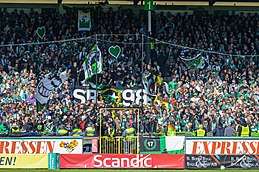
The club's nickname is "Bajen" (Swedish pronunciation: [ˈbǎjɛn]). A fan of Hammarby is referred to as a bajare or a hammarbyare.
Hammarby has historically been regarded as a club with a mainly working-class fan base, due to its connection with the formerly working-class (but today gentrified) Södermalm district of Stockholm. Nowadays the club attracts fans from all parts of society.[38][39] According to a 2016 poll, a large part of the club's fan base tends to support left-wing politics compared to those of their local rivals AIK and Djurgården.[40]
Hammarby has strong ties to Söderort, the southern part of Stockholm urban area.[38] A 2012 poll showed that Hammarby was the most popular club in Söderort; 40 percent of the area's residents who had a favourite club chose Hammarby.[41]
Hammarby's training ground, Årsta Idrottsplats, is located in the district of Johanneshov, while some of the older youth teams still play at Hammarby IP in Södermalm.
Rivalries
The club's main rivals are Djurgårdens IF and AIK, also from the Stockholm urban area. Hammarby and Djurgården have been tenants at the same arena, Tele2 Arena, since 2013.
Attendances
As of 2019, Hammarby has had the highest average attendance in Scandinavia during the last six seasons.[5][42][43] The club's average attendance for the 2015 season was 25,507, a new record high for Swedish top-division football. The former record was set back in 1959, when Örgryte IS had an average home attendance of 25,490.[44]
| Season | Stadium | Capacity | Total | High | Low | Average | Occupancy |
|---|---|---|---|---|---|---|---|
| 2010 | Söderstadion | 12,882 | 102,953 | 11,479 | 4,950 | 6,863 |
53.3% |
| 2011 | 119,299 | 12,801 | 5,669 | 7,953 |
61.7% | ||
| 2012 | 126,947 | 12,153 | 5,179 | 8 463 |
65.7% | ||
| 2013 | Söderstadion and Tele2 Arena | 12,882 and 30,000 | 181,449 | 29,175 | 7,886 | 12,096 |
55% |
| 2014 | Tele2 Arena | 30,000 | 306,762 | 31,074 | 11,936 | 20,450 |
68,2% |
| 2015 | 382,607 | 30,869 | 18,173 | 25,507 |
85% | ||
| 2016 | 343,281 | 31,756 | 18,119 | 22,885 |
76.3% | ||
| 2017 | 332,052 | 30,671 | 17,403 | 22 136 |
73,4% | ||
| 2018 | 355,194 | 31,810 | 17,896 | 23,679 |
78,9% | ||
| 2019 | 363,481 | 31,337 | 18,475 | 24,232 |
80,8% | ||
Notable supporters

Hammarby has had a slew of celebrity fans throughout the years, mostly cultural professionals living in Södermalm. In 1942, the popular recording artist Alice Babs released a version of the song Vårat gäng ("Our Gang") with new, Hammarby-related lyrics.[45] Critically acclaimed author Per Anders Fogelström, who rose to fame with his 1960 novel Mina drömmars stad ("City of My Dreams"), with a narrative that follows a group of working-class people in Södermalm between 1860 and 1880, was also a supporter of Hammarby.[46] In 1962, writer and illustrator Stig "Slas" Claesson penned a short story, Supportern ("The Supporter"), about his love for the club.[47]
Hollywood actors Alexander Skarsgård and Joel Kinnaman are supporters of Hammarby, and have acted in several skits to promote the club.[48]
Club culture
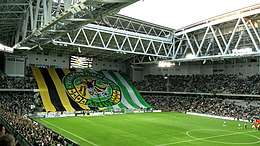
The club's unofficial hymn is "Just idag är jag stark". Released in 1979, it was performed and co-written by Kenta Gustafsson, who was a notable Hammarby fan. The recording has been the team's entrance music since 2004.[49]
Hammarby has several supporter clubs, the largest of which, Bajen Fans, had over 6,000 members in 2012 and is one of the largest in Scandinavia.[50] Hammarby also has a number of ultras such as Hammarby Ultras, Ultra Boys, Söder Bröder, and E1 Ultras – who together organize the club's terrace choreography. Hammarby Ultras won "tifo of the year" in both 2000 and 2005, an award handed out by the Swedish Football Association.[51]
The club is known for its vociferous fans. Drawing inspiration from England, Hammarby fans introduced football chants to the Swedish terraces in 1970.[6] In the 1982 finals against IFK Göteborg, Hammarby supporters attracted much attention for bringing a live samba band to the stands to accompany their chants, inspired by supporters in South America.[52] In 2008, sports broadcaster Setanta Sports listed Söderstadion, Hammarby's home ground at the time, as the 11th noisiest stadium in the world.[53]
Before the first league home game of the season, Hammarby fans gather at Medborgarplatsen in Södermalm. They then march together along Götgatan and cross the Skanstullsbron bridge before arriving at the stadium in Johanneshov. This tradition has taken place since 1998 and annually attracts between 15,000 and 20,000 supporters.[38][54]
Players
First-team squad
Note: Flags indicate national team as defined under FIFA eligibility rules. Players may hold more than one non-FIFA nationality.
|
|
Current youth players with first-team experience
- As of 10 August 2020[upper-alpha 1]
Note: Flags indicate national team as defined under FIFA eligibility rules. Players may hold more than one non-FIFA nationality.
|
Out on loan
- As of 14 August 2020[57]
Note: Flags indicate national team as defined under FIFA eligibility rules. Players may hold more than one non-FIFA nationality.
|
|
Notable players
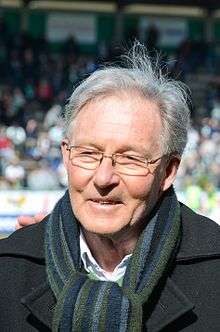
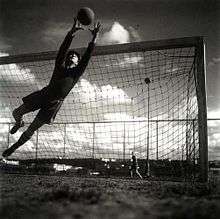
List criteria:
- player has made more than 300 appearances overall for the club, or
- player has won Guldbollen,[59] is a member of the Swedish football Hall of Fame,[60] has been named Allsvenskan top scorer of the year,[61] or
- player has been picked as a top ten club profile, decided by the supporters in 2004 in an official voting called "Tidernas största Bajenprofiler".[62]
| Name | Nationality | Hammarby Fotboll career |
Total appearances |
Total goals |
Guldbollen | Hall of Fame | Allsvenskan top goalscorer |
Top ten club profile |
|---|---|---|---|---|---|---|---|---|
| Sven Bergqvist | Sweden | 1932–1946 | 212 | 0 | Yes | |||
| Lennart Skoglund | Sweden | 1946–1949 1964–1967 |
113 | 28 | Yes | Yes | ||
| Ronnie Hellström | Sweden | 1966–1974 | 169 | 0 | 1971 1978 |
Yes | Yes | |
| Kenneth Ohlsson | Sweden | 1966–1983 | 396 | 83 | Yes | |||
| Mats Werner | Sweden | 1971–1984 | 251 | 46 | 1979 | |||
| Billy Ohlsson | Sweden | 1972–1978 1980–1986 |
219 | 94 | 1980 1984 |
Yes | ||
| Klas Johansson | Sweden | 1975–1989 | 314 | 12 | Yes | |||
| Ulf Eriksson | Sweden | 1979–1983 1985–1989 |
176 | 55 | Yes | |||
| Sten-Ove Ramberg | Sweden | 1979–1989 | 250 | 14 | Yes | |||
| Lars Eriksson | Sweden | 1985 –1988 1998–2001 |
123 | 0 | Yes | |||
| Mikael Hellström | Sweden | 1990–2005 | 301 | 18 | ||||
| Kennedy Bakircioglu | Sweden | 1999–2003 2012–2018 |
269 | 79 | Yes | |||
Management
Organisation
| Name | Role |
|---|---|
| Chairman | |
| Secretary | |
| Chief executive officer | |
| Deputy chief executive officer | |
| Director of football | |
| Technical director | |
| Head of scouting | |
| Head of youth academy | |
| Chief academy coach | |
| Head of club operations |
Technical staff
|
Coaching history
|
|
|
Honours
Domestic
- Swedish Champions[upper-alpha 3]
- Winners (1): 2001
League
- Allsvenskan
- Superettan
- Winners (1): 2014
- Division 1 Norra
- Division 1 Östra
- Winners (1): 1991
Cups
- Svenska Cupen
- Runners-up (3): 1976–77, 1982–83, 2010
- Svenska Mästerskapet
- Runners-up (1): 1922
European
- UEFA Intertoto Cup
- Winners (1): 2007 UEFA Intertoto Cup[67]
Futsal
- Swedish Futsal Championship
- Winners (1): 1994[68]
- Swedish Futsal League
International play
European games
Hammarby has occasionally qualified for play in competitions where the team has competed with clubs from other European countries.
| Season | Competition | Round | Country | Club | Home | Away | Agg. | Notes |
|---|---|---|---|---|---|---|---|---|
| 1983–84 | UEFA Cup Winners' Cup | First round | 17 Nëntori Tirana | 4–0 | 1–2 | 5–2 | ||
| Second round | Haka | 1–1 | 1–2 | 2–3 | ||||
| 1985–86 | UEFA Cup | First round | Pirin Blagoevgrad | 3–1 | 4–0 | 7–1 | ||
| Second round | St Mirren | 3–3 | 2–1 | 5–4 | ||||
| Third round | 1. FC Köln | 2–1 | 1–3 | 3–4 | ||||
| 1999 | UEFA Intertoto Cup | Second round | FC Gomel | 4–0 | 2–2 | 6–2 | ||
| Third round | Heerenveen | 0–2 | 0–2 | 0–4 | ||||
| 2002–03 | UEFA Champions League | Second qualifying round | Partizan | 1–1 | 0–4 | 1–5 | ||
| 2004–05 | UEFA Cup | Second qualifying round | ÍA | 2–0 | 2–1 | 4–1 | ||
| First round | Villarreal | 1–2 | 0–3 | 1–5 | ||||
| 2007 | UEFA Intertoto Cup | First round | Klaksvík | 1–0 | 2–1 | 3–1 | ||
| Second round | Cork City | 1–1 | 1–0 | 2–1 | ||||
| Third round | Utrecht | 0–0 | 1–1 | (a)1–1 | Winner | |||
| 2007–08 | UEFA Cup | Second qualifying round | Fredrikstad | 2–1 | 1–1 | 3–2 | ||
| First round | Braga | 2–1 | 0–4 | 2–5 | ||||
| 2020–21 | UEFA Europa League | First qualifying round | Puskás Akadémia | N/A | N/A |
Records
- Highest attendance, Råsunda Stadium: 35,929 (against IFK Lidingö, 14 September 1941)
- Highest attendance, Tele2 Arena: 31,810 (against BK Häcken, 4 November 2018)[70]
- Highest attendance, Söderstadion: 15,626 (against Malmö FF, 6 April 2004)
- Biggest win, Allsvenskan: 7–0 (against Halmstad BK, 1 October 1972); 7–0 (against Enköpings SK, 29 September 2003)
- Biggest loss, Allsvenskan: 1–9 (against Djurgårdens IF, 13 August 1990); 0–8 (against IFK Göteborg, 2 June 1925)
- Most goals scored, Allsvenskan: 94, Billy Ohlsson (1972–86)
- Most appearances (including non-league), total: 400, Kenneth "Kenta" Ohlsson (1966–83)
Other departments
Women
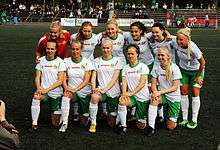
Hammarby IF DFF are the women's football club affiliated to Hammarby Fotboll. Hammarby Damfotbollförening was first founded in 1970 as a section under Hammarby IF. In 1999 the association was reorganized and all the underlying sections got separated into an umbrella organization.[33] Before the start of the 2017 season, Hammarby IF DFF was merged with Hammarby Fotboll.[71][72]
Hammarby won the top tier Damallsvenskan in 1985 and two national cups in 1994 and 1995.[73] In 1994 it was also the championship's runner-up. Previously, the team had been the cup's runner-up in its first three editions (1981–83).[74] The home ground of the women's team is Hammarby IP, although occasionally they have played competitive games at Zinkensdamms IP and Tele2 Arena.[75]
Futsal
In May 2016, Hammarby announced that they would establish a men's senior futsal team. Playing their home games in Eriksdalshallen, Hammarby competed in the Swedish second tier, Division 1 Södra Svealand, during their inaugural season.[76] In 2017, Hammarby won promotion to the Swedish Futsal League, the premier championship.[77]
Footnotes
- Current youth players who at least have sat on the bench in a competitive match.
- Hammarby IF have a cooperation with IK Frej and might temporarily loan out and recall players to them during the season.
- The title of "Swedish Champions" has been awarded to the winner of four different competitions over the years. Between 1896 and 1925 the title was awarded to the winner of Svenska Mästerskapet, a stand-alone cup tournament. No club were given the title between 1926 and 1930 even though the first-tier league Allsvenskan was played. In 1931 the title was reinstated and awarded to the winner of Allsvenskan. Between 1982 and 1990 a play-off in cup format was held at the end of the league season to decide the champions. After the play-off format in 1991 and 1992 the title was decided by the winner of Mästerskapsserien, an additional league after the end of Allsvenskan. Since the 1993 season the title has once again been awarded to the winner of Allsvenskan.[66]
Works cited
- Persson, Gunnar (1996). Hammarby IF: En klubbhistoria 1897–1997 (in Swedish). Strömbergs Bokförlag. ISBN 91-7151-097-4.
Notes
- "Bajen" is a short form of a mock-English pronunciation of "Hammarby".
- In 1982, IFK Göteborg, who won the Allsvenskan championship, would later go on to win the UEFA Cup, as the first, and so far only, Swedish team to do so.
- Cratz would later be cheered upon and praised by Hammarby fans in 2002 when he managed Swedish competing team Helsingborgs IF in a match against Hammarby.
References
- "Hammarby Fotboll: Kontakt" (in Swedish). Hammarby Fotboll. Retrieved 12 February 2018.
- "Zlatan Ibrahimović investerar i AEG Sweden - blir delägare i Hammarby Fotboll AB" (in Swedish). Hammarby Fotboll. 27 November 2019. Retrieved 27 November 2019.
- "Tabell och resultat - Allsvenskan, herrar" (in Swedish). Svenskfotboll.se. Retrieved 11 January 2017.
- "Maratontabell – Svenskfotboll.se". Svenskfotboll (in Swedish).
- "Den nordiska publikligan 2016". Ecst.se (in Swedish).
- "1970". Hifhistoria.se (in Swedish).
- "Edvard blev nummer 3000 i Bajens ungdomsled". Hammarby Fotboll (in Swedish). Retrieved 12 February 2018.
- "Hammarby IF Ungdom". Hammarby IF Ungdom (in Swedish). Retrieved 12 February 2018.
- "Kontaktuppgifter och tävlingar - Hammarby IF FF". Svensk Fotboll (in Swedish). Retrieved 27 November 2019.
- Persson, p. 17.
- "Historia". Hammarby Fotboll (in Swedish). Retrieved 12 September 2017.
- Persson, p. 15-17
- Persson, p. 60-62
- "Hammarby IF utökas med en fotbollssektion 1915". Stockholmskällan (in Swedish). Retrieved 20 February 2018.
- "1915". HIF Historia (in Swedish). Retrieved 12 September 2017.
- "1916". HIF Historia (in Swedish). Retrieved 12 September 2017.
- Persson, p. 65.
- "1921". HIF Historia (in Swedish). Retrieved 12 September 2017.
- "1922". HIF Historia (in Swedish). Retrieved 12 September 2017.
- "1925". HIF Historia (in Swedish). Retrieved 12 September 2017.
- "1937". HIF Historia (in Swedish). Retrieved 12 September 2017.
- "1938". HIF Historia (in Swedish). Retrieved 12 September 2017.
- "1939". HIF Historia (in Swedish). Retrieved 12 September 2017.
- "The Mavericks: Lennart 'Nacka' Skoglund". Espn Fc. 6 September 2012. Retrieved 13 March 2014.
- "sweden 1981–90". Webalice.it. Retrieved 13 March 2014.
- "Division 1 (2nd level) 1989". Home.swipnet.se. Archived from the original on 13 March 2014. Retrieved 13 March 2014.
- "sweden 1991-00". Webalice.it. Retrieved 13 March 2014.
- "Åtta raka räckte inte – lilla silvret till Bajen" (in Swedish). Hammarby Fotboll. 2 November 2019. Retrieved 4 November 2019.
- "Year: 1889". HIF Historia. Retrieved 25 January 2018.
- "Historiska nedslag: När Hammarby fick tigerränder". Supportrarnas matchprogram. 5 December 2017. Retrieved 29 January 2018.
- "Hammarby Fotboll och Craft – största partnersamarbetet i klubbens historia". Hammarby Fotboll. 5 January 2019. Retrieved 5 January 2019.
- "Huvudsponsorer". Hammarbyfotboll.se. Retrieved 2 March 2016.
- "Historia". Hammarby-if.se. Retrieved 13 March 2014.
- "Fakta: 51-procentsregeln" (in Swedish). SVT. 22 May 2013. Retrieved 27 November 2019.
- "Organisation" (in Swedish). Hammarby Fotboll. Retrieved 26 October 2018.
- "Positivt ekonomiskt resultat för Hammarby Fotboll" (in Swedish). Hammarby Fotboll. 3 March 2020. Retrieved 3 March 2020.
- "Odilon klar för Club Brügge" (in Swedish). Hammarby Fotboll. 8 May 2019. Retrieved 3 March 2020.
- "In Bajen we trust" (in Swedish). Fokus. 21 April 2017. Retrieved 20 February 2018.
- "104 långa års längtan efter guld" (in Swedish). Aftonbladet. 8 March 2011. Retrieved 27 February 2018.
- "Fotbollssupportrar – såhär är ni" (in Swedish). KIT. 1 April 2016. Retrieved 20 February 2018.
- "Hammarby störst i södra Stockholm". Stockholm Direkt. Retrieved 14 January 2016.
- "Nordens största publiklag 2015". Ecst.se (in Swedish).
- "Den nordiska publikligan 2014". Ecst.se (in Swedish).
- "Rekordstödet – Hammarby har störst publik genom tiderna". Retrieved 23 July 2015.
- "Julkalendern, lucka 23: Sjung om klubben nummer ett!". Hammarby Fotboll (in Swedish). 2016.
- "Fogelström 100 år: Södermalm var hans hem". MittI (in Swedish). 23 May 2017.
- "Huliganer slog ned Slas, 72". Aftonbladet (in Swedish). 27 October 2001.
- "Skarsgård hjälper Hammarby i kris". Aftonbladet.se (in Swedish). 19 May 2010.
- "Just idag är jag stark!". Hammarbyfotboll.se (in Swedish). 14 April 2014. Archived from the original on 9 November 2014.
- "Bajen Fans största supporterklubben någonsin – Superettan". Fotbollskanalen.se (in Swedish). 1 January 2012.
- "CANAL+ tifopris till Hammarby Ultras". Svenska Fotbollförbundet (in Swedish). 29 November 2005. Retrieved 23 February 2018.
- "30 år sedan SM-finalerna". Hammarbyfotboll.se (in Swedish). 31 October 2012. Archived from the original on 9 November 2014.
- "Söderstadion bättre än Nou camp – Allsvenskan 2008 – Fotboll – Eurosport". Eurosport.se (in Swedish). 22 April 2008.
- "Sent bärgad grönvit poäng i premiärfesten". Hammarby Fotboll (in Swedish). 9 April 2017. Retrieved 23 February 2018.
- "A-laget" (in Swedish). Hammarby Fotboll. Retrieved 7 July 2013.
- "Årets tröjnummer i herrlaget" (in Swedish). Hammarby Fotboll. Retrieved 31 March 2019.
- "A-laget: Truppen" (in Swedish). IK Frej. Retrieved 7 May 2020.
- "Bajen pensionerar hans nummer i tio år framöver" (in Swedish). Expressen. Retrieved 4 November 2018.
- "Guldbollen". svenskfotboll.se (in Swedish). The Swedish Football Association. Retrieved 19 January 2016.
- "Hall of Fame". svenskfotboll.se. Retrieved 19 January 2016.
- "Allsvenska skyttekungar & publiksnitt 1924/25-". svenskfotboll.se (in Swedish). The Swedish Football Association. Retrieved 22 May 2016.
- "Historik" (in Swedish). Hammarby Fotboll. Archived from the original on 26 March 2011. Retrieved 1 March 2017.
- "Kontakt" (in Swedish). Hammarby Fotboll. Retrieved 26 October 2018.
- "Spelare U19" (in Swedish). Hammarby Fotboll. Retrieved 26 October 2018.
- "Spelare U17" (in Swedish). Hammarby IF Fotbollförening. Retrieved 26 October 2018.
- "Svenska mästare 1896–1925, 1931–". svenskfotboll.se (in Swedish). Retrieved 25 November 2009.
- https://archive.is/20130105120348/http://en.archive.uefa.com/competitions/intertotocup/history/season=2008/intro.html
- SM i futsal - segrare genom åren —. Svenskfotboll.se.
- "Svenska Futsalligan" (in Swedish). Svenska Fotbollförbundet. Retrieved 22 April 2019.
- "Nytt publikrekord på Tele2 Arena – och vinst i publikligan". Hammarby Fotboll. 4 November 2018.
- "Hammarby Damfotboll går samman med Hammarby Fotboll". Hammarby Damfotboll (in Swedish). 11 November 2016. Archived from the original on 2 February 2017. Retrieved 31 January 2017.
- "Hammarby IF FF välkomnar damlaget och äldre flickor in i organisationen". Hammarby Fotboll (in Swedish). 11 November 2016.
- "Svenska mästarinnor & publiksnitt 1973-". SVFF (in Swedish). 31 January 2017.
- "List of finals". RSSSF. 31 January 2017.
- "Hammarbydamerna på Tele2 Arena". Dagens Nyheter (in Swedish). 2 April 2015.
- "Hammarby IF FF startar futsallag". Hammarby Fotboll (in Swedish). 20 May 2016.
- "Futsal: Hammarby klart för SFL efter kvaldrama". Hammarby Fotboll (in Swedish). 26 February 2017.
External links
| Wikimedia Commons has media related to Hammarby IF Fotboll. |
